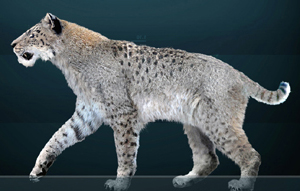Homotherium sp.

Phylum: Chordata Haeckel, 1874
Subphylum: Vertebrata Cuvier, 1812
Classe: Mammalia Linnaeus, 1758
Ordine: Carnivora Bowdich, 1821
Famiglia: Felidae Fischer von Waldheim, 1817
Genere: Homotherium Fabrini, 1890
Descrizione
Questo grande felide, appartenente alla sottofamiglia delle tigri dai denti a sciabola, era caratterizzato dall'aspetto pendente, simile a quello di una iena. Questa caratteristca era data dal fatto che gli arti anteriori erano sostanzialmente più lunghi di quelli posteriori. Il cranio era robusto e dotato di forti canini allungati, anche se non così allungati come quelli di Smilodon. L'omoterio vagava per le pianure dell'Eurasia e del Nordamerica in cerca di prede, che erano costituite dai grandi ungulati dell'Era glaciale e dell'Interglaciale. Di questo animale, impropriamente detto anche "tigre dai denti a scimitarra", sono note varie specie: tra le più note, da ricordare le europee H. crenatidens e H. latidens, e la nordamericana H.serum. Molti esemplari di quest'ultima specie sono stati rinvenuti nelle caverne del Texas, nella grotta di Friesenhahn. Altri fossili di Homotherium sono stati rinvenuti in Cina, in Francia, in Inghilterra e in Italia.
Diffusione
Mammifero carnivoro fossile, caratteristico del Pliocene e del Pleistocene di Europa, Asia e Nordamerica.
Bibliografia
–Antón, Mauricio. Sabertooth. Indiana University Press, 2013.
–"American Scimitar Cat". Yukon Beringia Interpretive Center. Retrieved 19 February 2018. The scimitar cat was the second largest feline species to live in Yukon during the Ice Age (after the Beringian lion) - weighing in around 200 kilograms.
–PaleoBiology Database: Homotherium, basic info.
–Turner, A. (1997). 'The big cats and their fossil relatives. Columbia University Press. ISBN 0-231-10229-1.
–Reumer, J.W.F.; L. Rook; K. Van Der Borg; K. Post; D. Mol; J. De Vos (2003). "Late Pleistocene survival of the saber-toothed cat Homotherium in northwestern Europe". Journal of Vertebrate Paleontology. 23: 260.
–Rincón, A., Prevosti, F., & Parra, G. (2011). New saber-toothed cat records (Felidae: Machairodontinae) for the Pleistocene of Venezuela, and the Great American Biotic Interchange Journal of Vertebrate Paleontology, 31 (2), 468-478.
–Fabrini, E. (1890). ""I Machairodus (Meganthereon) del Val d'Arno superiore"". Bollettino Comitato Geologico d'Italia. 21: 121-144, 161-177, esp. 176.
–R. L. (1891). "III.-Dr. E. Fabrini on Machærodus - Machærodus (Meganthereon) del Valdarno Superiore, Memoria del Dott. Emilio Fabrini (Boll. R. Com. Geol. 1890 Nos. 3-6, pp. 43, pls. 3.)". Geological Magazine. 8 (2): 82.
–Paijmans, J. L. A.; Barnett, R.; Gilbert, M. T. P.; Zepeda-Mendoza, M. L.; Reumer, J. W. F.; de Vos, J.; Zazula, G.; Nagel, D.; Baryshnikov, G. F.; Leonard, J. A.; Rohland, N.; Westbury, M. V.; Barlow, A.; Hofreiter, M. (2017-10-19). "Evolutionary History of Saber-Toothed Cats Based on Ancient Mitogenomics". Current Biology. 27 (21): 3330-3336.e5.
–Alan Turner: "The Evolution of the guild of larger terrestrial carnivores during the Plio-Pleistocene in Africa". Geobios, no 23, fasc. 3, p. 349-368, 1990.
–(BBC News) Paul Rincon, "Big cat fossil found in North Sea", 18 November 2008 accessed 18 November 2008.
–Sanchez, Fabiola (2008-08-21). "Saber-toothed Cat Fossils Discovered". Associated Press. Retrieved 2017-10-20.
–Orozco, José (2008-08-22). "Sabertooth Cousin Found in Venezuela Tar Pit -- A First". National Geographic News. National Geographic Society. Retrieved 2008-08-30.
–Rincón, A. D.; Prevosti, F. J.; Parra, G. E. (2011-03-21). "New saber-toothed cat records (Felidae: Machairodontinae) for the Pleistocene of Venezuela, and the Great American Biotic Interchange". Journal of Vertebrate Paleontology. 31 (2): 468-478.
–Rawn-Schatzinger, V. (1992). "The scimitar cat H. serum (Cope)". Report of Investigations (47): 1-80.
–W. D. Matthew. 1910. Bulletin of the American Museum of Natural History 28.
–C. B. Schultz et al. 1970. Bulletin of the Nebraska State Museum 9.
–W. W. Dalquest and R. M. Carpenter. 1988. Occasional Papers, Museum, Texas Tech University 124.
–Sorkin, B. 2008: A biomechanical constraint on body mass in terrestrial mammalian predators. Lethaia, Vol. 41, pp. 333-347.
–Meade, G.E. 1961: The saber-toothed cat Dinobastis serus. Bulletin of the Texas Memorial Museum 2(II), 23-60.
–Switek, Brian. "Did Saber Cats Have Spotted and Striped Coats?". scientificamerican.com. Retrieved 23 April 2018.
–M. Anton et al.: Co-existence of scimitar-toothed cats, lions and hominins in the European Pleistocene. Implications of the post-cranial anatomy of Homotherium latidens (Owen) for comparative palaeoecology. Quaternary Science Reviews 24 (2004).
–"Deinotheres for lunch? A sabertooth's tough-skinned diet". 2017-03-23.
–Metcalfe, Jessica Z. "Late Pleistocene Climate and Proboscidean Paleoecology".
–"The Diet of Saber-Toothed Cats". 2008-03-07.
–Antón, Mauricio (2013). Sabertooth. Bloomington, Indiana: University of Indiana Press. pp. 227–228. ISBN 9780253010421.